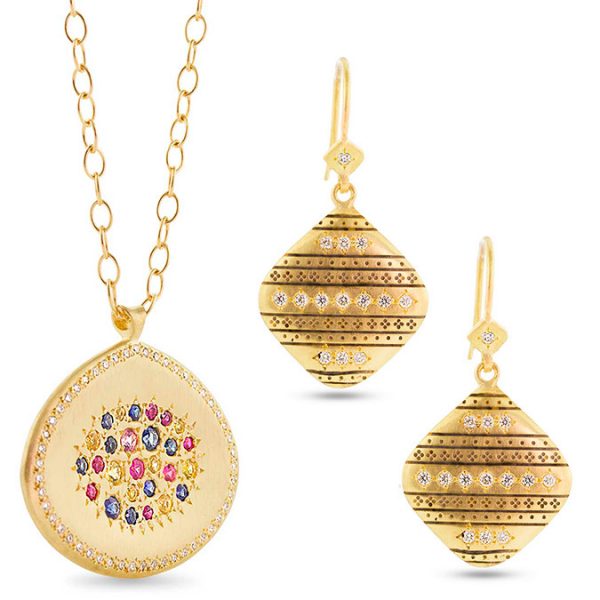
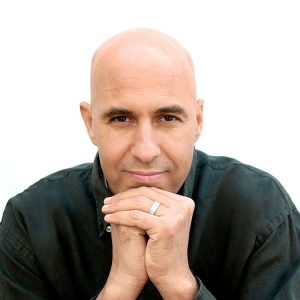 It’s a blustery late-November day in New York’s Hudson Valley, and designer Adel Chefridi is at his bench on the second floor of his Kingston, N.Y., studio, painstakingly engraving the charm of an earring. He covers the charm with a black Sharpie and polishes off the ink, leaving behind a slight shadow in the grooves of the engraving.
It’s a blustery late-November day in New York’s Hudson Valley, and designer Adel Chefridi is at his bench on the second floor of his Kingston, N.Y., studio, painstakingly engraving the charm of an earring. He covers the charm with a black Sharpie and polishes off the ink, leaving behind a slight shadow in the grooves of the engraving.
“Air moves the metal in an intentional way,” he explains. “A lot of things don’t come to life until the last moment, when you’re polishing.”
The engraving is delicate and artful. After design, stone setting and engraving are Chefridi’s bailiwick, but he resists being categorized.
“It feels when you identify yourself as something, you’ve caged yourself,” he says. “And you set expectations. At some point, I accepted the label of designer, with precaution. I’m not a jeweler in the classic term. So, if you come to me to make a general work, I will send you to a jeweler, because it’s not what I do. We don’t do things in hundreds. We’ll do two, three pieces. It’s the stones that make the piece unique.”
The studio produces pieces that you’ll see in galleries (Art + Soul in Boulder, Colo., for example) or catalogs (Sundance), but the designer’s handcrafted one-of-a-kind works are his main concentration. And those are defined by his love of stones. “The stones come first,” he says.
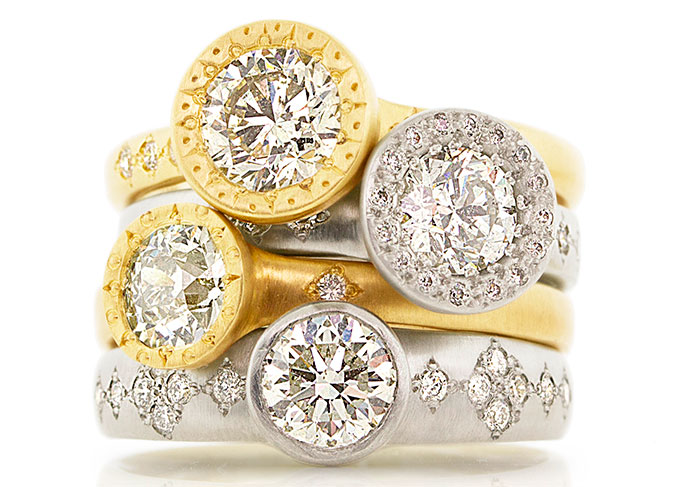
Chefridi came to New York City from Tunisia in 1998 to study jewelry-making. He learned his craft at GIA and took an intensive diamond-setting class at Studio Jewelers Ltd. in Manhattan. He met his wife and business partner, Corinne, a few weeks after his arrival—on the subway. Chefridi had a showroom in Manhattan, and he and Corinne lived in Brooklyn with their two girls. After 10 years of city living and spending many weekends at their beloved cabin in Ulster County, the family moved to Woodstock, N.Y. On the Woodstock property, he built a two-story studio, which he eventually outgrew, so he moved into his current airy space in Kingston’s Stockade District in 2016.
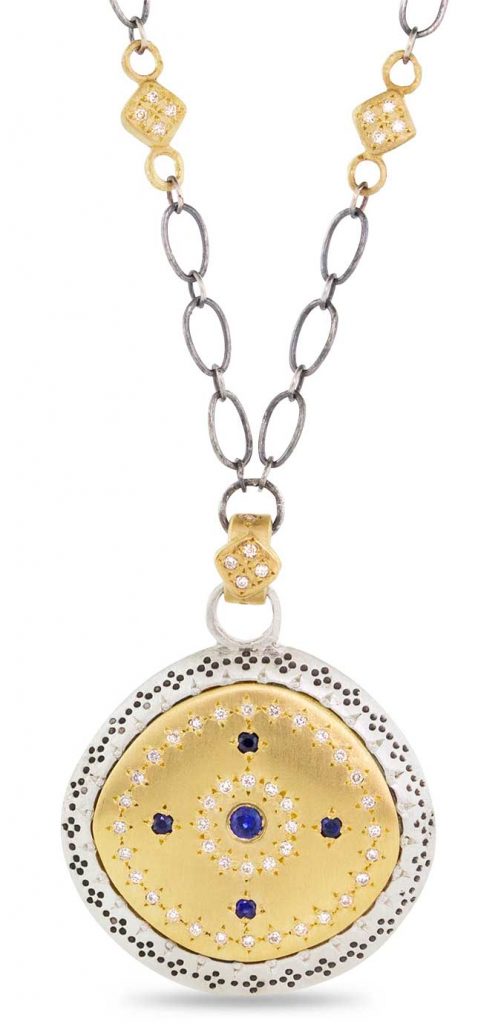 The studio is just a few blocks from where the British tried to burn Kingston, the first capital of New York, to the ground during the Revolutionary War in October 1777. The choice of locale is fitting. Kingston has seen its share of hard times, but it’s experiencing a true resurgence as an influx of artists, designers, and other creators have moved into the area in search of a less hectic lifestyle and more affordable housing options that will allow them to continue making art.
The studio is just a few blocks from where the British tried to burn Kingston, the first capital of New York, to the ground during the Revolutionary War in October 1777. The choice of locale is fitting. Kingston has seen its share of hard times, but it’s experiencing a true resurgence as an influx of artists, designers, and other creators have moved into the area in search of a less hectic lifestyle and more affordable housing options that will allow them to continue making art.
Chefridi, always the artist, feels perfectly at home. “I grew up in a poor environment, so we didn’t have things, but we made things,” he says. “We didn’t have a ball, so we made a ball. So, it was creative in that sense. Creativity was part of playing.”
His studio is creativity made tangible. Two young jewelers, Jen and Rose, work at their respective benches across the studio. Jen works on a necklace with colored sapphires from Madagascar, and accompanying those gems in a tray on her bench are two stunning Mozambican rubies.
Chefridi teaches his assistants to set stones. Both Jen and Rose went to “very good schools, but they didn’t learn to set stones,” he says. The first employee he taught to set stones has since ventured out on his own as an independent jeweler. Chefridi says, with complete humility, that you can’t tell the difference between his stone setting and his former apprentice’s, except that the apprentice’s settings “are better, because he does it all the time.”
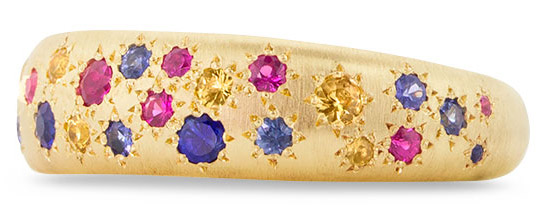 The artist is not the only one responsible for design. “The whole studio is participating,” he says. “We sit together and meet all the time. We discuss projects together, and then we start implementing those projects. I like that participation and the creative process. We take things from idea to finished piece.”
The artist is not the only one responsible for design. “The whole studio is participating,” he says. “We sit together and meet all the time. We discuss projects together, and then we start implementing those projects. I like that participation and the creative process. We take things from idea to finished piece.”
Sketches are usually drawn before the wax casting process takes place, but occasionally a piece goes straight to the casting room. “Sometimes we just go for it,” Chefridi says, smiling.
Quality control, another of Chefridi’s responsibilities, is a vital component of his design ethos. “There is a new group of designers that says you can be creative, you can break the mold, you can go to new territory without compromising the quality,” he says. “To do something new, you don’t need to break all the rules. The difference between a work of art that you hang on a wall and a necklace is that you’re going to wear that necklace, so it’s important that it doesn’t break or that the stones don’t fall out. It’s important for a ring to be comfortable.
“Those are practical things,” he adds. “You want to bring the aesthetic ideals to the bench and [at the same time] do practical things.”
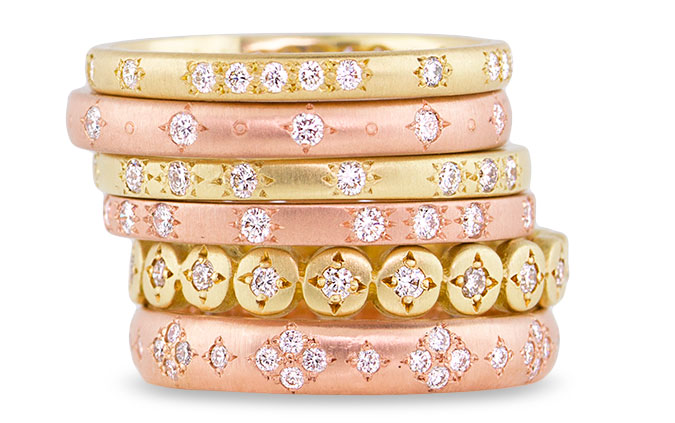
That distinction is evident in Chefridi’s ability to stand in the shoes of his wearer and understand what she (or he) needs and wants from him in a piece. “There is a user here that you need to be aware of—that is design,” he says. “When you’re an artist you can do anything you want for yourself. You can make a painting or a piece of music any way you want. When you’re a designer, you’re bound by the usability of that piece. There is an element of, almost, compassion in it, because you have to picture yourself in that position. It’s not just me. Design is an inclusive experience. It’s not an individual experience. You have to immerse yourself in the other, too.”
Chefridi is adept in immersing himself in “the other,” and not only from a design viewpoint. When JCK visited, he was prepping for his post-Thanksgiving open studio and sample sale as well as the upcoming winter shows: NY Now, JCK Tucson, and American Craft Show Baltimore. The Baltimore show, he explains, is perfect for his work because the “people really appreciate the colored stones. Showgoers are more art oriented, not classic jewelry stores.”
This is why Debbie Klein’s Art + Soul gallery in Boulder is such a popular outlet for Chefridi’s work. “Debbie sells jewelry and paintings,” he says. “She used to work at Christie’s, and she has a sharp eye.”
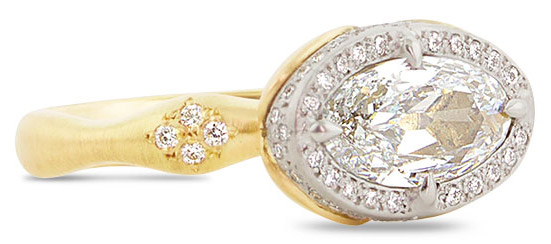 Chefridi shows new designs at each show he attends. At JCK Tucson in February, he will be unveiling a multicolored sapphire collection as well as the engraved 18k gold and diamond Nomad collection.
Chefridi shows new designs at each show he attends. At JCK Tucson in February, he will be unveiling a multicolored sapphire collection as well as the engraved 18k gold and diamond Nomad collection.
He genuinely enjoys talking to people at shows—and watching as they try on his pieces. “When I see women trying pieces on at shows, they don’t look at the piece itself; they look at how they look in the piece,” he says. “They’re not trying to be more beautiful or be someone else—they’re trying to access their own beauty.
“I get a lot of design ideas when I talk to people and when I see people try things on. I take notes on the back of a receipt. I have a folder of little receipts, little scribbles. That’s when the creativity happens.”
Jewelry from top: Multi Sapphire Lights pendant in 18k yellow gold with 0.4 ct. t.w. multicolored sapphires and 0.15 ct. t.w. diamonds on 16-inch chain, $5,490, Nomad earrings in 18k yellow gold with 0.26 ct. t.w. diamonds, $5,200; semimounts in 18k yellow gold and platinum with 0.03 ct–0.5 ct. t.w. diamonds, $2,250–$3,750; Nostalgia Harmony pendant in sterling silver and 18k yellow gold with sapphire and 0.14 ct. t.w. diamonds on 18-inch oxidized silver chain, $3,375; Tapered Multi Sapphire ring in 18k yellow gold with multicolored sapphires, $2,465; bands in 18k yellow and 18k rose gold with 0.16 ct.–0.33 ct. t.w. diamonds, $1,875–$3,500; Crown-set solitaire semimount in platinum and 18k yellow gold with 0.18 ct. t.w. diamonds, $5,840; Adel Chefridi; 866-428-8777; chefridi.com